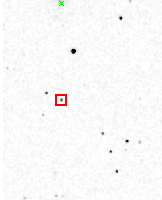2MASS
| 2MASS logo | |
| Organization | UMass IPAC (JPL / Caltech) NASA · NSF |
|---|---|
| Wavelength | infrared (2 m, 1.25 m, 1.65 m, 2.17 m) |
| Data products | images point source catalogue extended object catalogue |
| Website | About 2MASS Point sources catalogue Extended sources catalogue |
| | |

Observations for the Two Micron All-Sky Survey (2MASS)[1] began in 1997 and were completed in 2001[2] at two telescopes located one each in the northern and southern hemispheres (Mt. Hopkins, Arizona and Cerro Tololo/CTIO, Chile, respectively) to ensure coverage of the entire sky. The most ambitious project to map the night sky to date, the final (post-processing) data release for 2MASS occurred in 2003. The whole sky was covered using a photometric system of three infrared wavebands around 2 micrometres (m): J (1.25 m), H (1.65 m), and Ks (2.17 m).
The goals of this survey included:
- Detection of galaxies in the "Zone of Avoidance", a strip of sky obscured in visible light by our own galaxy, the Milky Way.
- First detection of brown dwarfs such as 2MASS 0939-2448, 2MASS 0415-0935, 2M1207, and 2MASS J04414489+2301513. As of 2003, 2MASS had discovered 173 brown dwarfs.[3]
- An extensive survey of low mass stars, the most common type of star both in our own galaxy and others.
- Cataloging of all detected stars and galaxies.
This last goal has been admirably achieved. Numerical descriptions of point sources (stars, planets, asteroids) and extended sources (galaxies, nebulae) were cataloged by automated computer programs to an average limiting magnitude of about 14. More than 300 million point sources and 1 million extended sources were cataloged. In November 2003, a team of scientists announced the discovery of the Canis Major Dwarf Galaxy, at that time the closest known satellite galaxy to the Milky Way, based on analysis of 2MASS stellar data.
The resulting data and images from the survey are currently in the public domain, and may be accessed online for free by anyone.[4] There is also a list of 2MASS science publications with links to free pre-publication copies of the papers.[5]
2MASS is sponsored by the University of Massachusetts Amherst (AKA UMass, and the origin of the survey name), the Infrared Processing and Analysis Center (IPAC, run by Jet Propulsion Laboratory (JPL) and Caltech), NASA, and the National Science Foundation (NSF).
See also
References
- ^ "About 2MASS (A Brief Explanation of 2MASS)". University of Massachusetts, Infrared Processing and Analysis Center (JPL/ Caltech), NASA, NSF. 2006-02-01. Retrieved 2008-09-21.
- ^ "Two Micron All Sky Survey (2MASS)". NASA/IPAC Infrared Science Archive. Retrieved 2011-10-22.
- ^ Kirkpatrick (2003). "2MASS Data Mining and the M, L, and T Dwarf Archives" (PDF). IAU Symposium Vol. 211 ("Brown Dwarfs"). 211. arXiv:astro-ph/0207672v1. Bibcode:2003IAUS..211..189K.
- ^ "2MASS Data Access". The Two Micron All Sky Survey at IPAC. December 20, 2006. Retrieved September 2, 2012.
- ^ "2MASS Science Publications". The Two Micron All Sky Survey at IPAC. February 1, 2006. Retrieved September 2, 2012.

